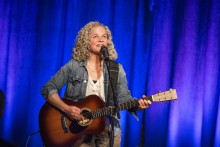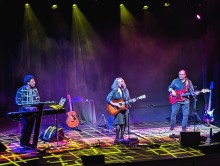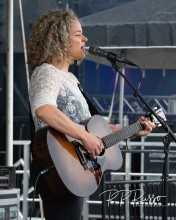On the CreativeGround With...
Lara Herscovitch [View profile]
Posted May 8, 2025 (edited for length)

Q: What is a typical day like for you as a singer-songwriter in New England?
{LH}: Good question, I think it’s a 365-part answer! But kidding aside, days probably group into 10 or 15 different types. I might be behind the wheel driving to a concert, near or far. I might be going to a recording studio or meeting a filmmaker to plan or film a music video. On the way, I’m catching up on the phone or listening to a podcast or audio book. If I’m home, a day might be creative, writing something new. Or polishing what’s already written, rehearsing solo or with my new trio, the Highway Philosophers. More time than I’d like to admit is admin-focused, on a laptop—working with venues to book concert dates, updating web listings, social media, editing concert video—that list goes on and on. I might be guest-presenting at a friend’s college music class or a nonprofit. Some days, it’s finding balance in cooking, baking—I’m deep in sourdough bread-land—stretching, yoga, swimming, or walking at Hammonasset or another of Connecticut’s state parks.
Q: You’ve done many beautiful performances, presentations, and workshops in New England—could you tell us about some of your favorite projects?
{LH}: Thank you, that means a lot. Music truly isn’t just what I do, it’s also who I am—not an uncommon feeling for artists in any discipline, I think. It’s an honor and privilege to do this work, especially right now. I’m deeply aware that so many talented and passionate people around the region, country, or globe don’t currently have the opportunity—one recent example in Afghanistan I just learned about through a podcast and documentary, is Afghan Star. My favorite projects always involve collaboration with other artists. Right now, that’s my new trio, the Highway Philosophers, alongside two friends, David Childs and Pierce Campbell (a fellow former CT State Troubadour), plus Kevin James, when his schedule allows. It’s such a fun project, combining our different musical backgrounds in singer-songwriter-Americana-new-folk, pop-rock, and jazz. For most of my touring history, I’ve played solo. It’s such a joy to also be on a team in arranging and performing, and to offer a bigger sound for those venues and audience members who prefer it. I love the recording studio too, figuring out how to best lift up a song. Most recently, I worked with Stephen Murphy in the Bronx on my single “Italian Balconies” and album Highway Philosophers. It’s a very special thing to share—creating “third spaces” of different kinds—not work, not home, but arts-focused places of connection and community and soul.

Q: What do you do to stay inspired? What fuels your work?
{LH}: Partly, I can’t not write. In many ways, it’s how I make sense of things. Though I started writing as a little kid, I got started in professional music quite late—so I’m motivated to honor that integrity, being integrated, being who I am. I’ve always been motivated by the Ray Charles quote, “I never wanted to be famous, I only wanted to be great.” That intention sits alongside a core value of contribution; I want to make a positive difference through music, paying it forward—honoring and giving to and through music all that it has given me. Other artists are definitely inspiring. I love hearing other songwriters, seeing musicals and plays, visiting museums, comedy shows, pottery studios, that kind of thing. Julia Cameron calls it “filling the well” in The Artist’s Way.
Q: What was a memorable New England creative business or cultural nonprofit you visited and what did you see? Are there other New England artists, creative businesses, or cultural nonprofits we should all know about?
{LH}: I was actually just at the Yale University Art Gallery in downtown New Haven, Connecticut. My first stop is always the Modern and Contemporary Art Department, and two Rothko paintings that hang side by side. I could just sit and stare and dream at them all day. One of them wasn’t there, and I was amazed at how differently the one that remained felt without the other. I’m not a “visual person,” but there is so much color and vibrancy in that building, including modern-day pieces by Kehinde Wiley and Titus Kaphar. I really appreciate that it’s free and open to the public.
There really are too many to name them all. But another that stands out is a recent collaboration that happened because of CreativeGround. I was invited to play the outdoor summer concert series at Canterbury Shaker Village, which sits on nearly 700 protected acres of New Hampshire. No pun intended, I resonated with their priorities of community, equality, non-violence, and living simply, close to and in deep respect of the natural environment.
Q: What do you think working artists look for when determining where to live and work?
{LH}: Three immediately come to mind:
First, affordability. The lower we can keep our overhead and the more we can pay off debt and save, the more options we have as artists, the more risks we can take, the more projects we can produce, and the longer we can stay healthy and in the field. I don’t mean to suggest that it’s easy. If we’re lucky, it’s a marathon, not a sprint.
Second, access to career resources. This varies of course, depending on the arts discipline and anyone’s specific goals and dreams. For the performing arts, is there a density of venues where we can play (or dance, etc.) and support others doing the same? Are there teachers and coaches nearby? Is there a healthy community to join or help build? Are there nonprofits like NEFA that are helping us connect and grow? Are there individuals and organizations nearby to collaborate with and dream of new possibilities?
Third, what kind of specific habitat keeps us healthy. As musicians, many of us are sensitive to our sonic environment. If we’re in a city, some of us still crave quiet at home and soundproof spaces to work, which are hard to find. But living in a more rural area can be isolating, so we have to be more intentional to stay connected when we’re not touring.
Q: How does CreativeGround serve you as an artist?
{LH}: It’s so challenging for any individual artist to be found, heard, seen. CreativeGround has introduced me and my music to others that I probably never would have known about otherwise. New England is like a small town in some ways, and in other ways it’s a huge, diverse place with a density of venues, organizations, and resources that are hard to figure out and navigate. CreativeGround is such a helpful tool, guide, and map pointing to what is possible: all the partnerships that can match and amplify our vision and values. Anything that makes that messy process more collaborative and effective and efficient? Count me in.

Q: Why should other New England artists, creative businesses, and cultural nonprofits be listed on CreativeGround?
{LH}: Not to put too fine a point on it, but truly, connection is everything. I’ve been leaning into Robert Putnam’s Bowling Alone research that started 30 years ago, plus our most recent outgoing U.S. Surgeon General Dr. Vivek Murthy’s “Parting Prescription for America.” Both of them investigated and articulated the ways our country—and in some ways our world—is experiencing a pandemic of isolation, loneliness, and disconnection. The more ways we can find each other, work together, and lift each other up, the healthier we will be, individually and collectively. I’m so grateful to NEFA and CreativeGround for giving us such a powerful tool to build bridges in New England within and between each of the artistic disciplines.
Q: Could you tell us about any projects you’re currently working on?
{LH}: Beyond my new group, the Highway Philosophers, I’m also exploring a different kind of musical writing. Up until now, six of my seven full-length albums were a collection of songs organized by a certain period of time. One exception was a concept album I released in 2012, on themes of the civil and human rights crisis of mass incarceration in the United States.
Currently, I’m working on songs that are told through the eyes of 3-5 different characters who, together, are telling a larger story arc. It’s called “Gravity Hill,” set at a topographical anomaly in rural, northeast Connecticut. If you stop your car at a certain spot on Sterling’s Main Street, put the gear in neutral and take your foot off the brake, you’ll feel your car rolling uphill—seemingly defying the laws of gravity.
Some think it’s is caused by witchcraft. Others, by magic, or magnetic forces. No matter the cause, four characters find their way to the mystery and beauty of Gravity Hill: a local woman’s ghost, a crow, a lighthouse keeper, and an armadillo. Theirs is a story of overcoming loneliness and isolation, and forging connection and community. And somehow, together, they will need to figure out how to confront and stop the force that arrives to profit from, and ultimately risks destroying, the magic and promise of it all.
Amazing. Thank you so much for the work that you do and for sharing it with us!
Until next time, where we deep dive into another CreativeGround profile. Stay creative!